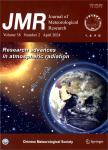A Case Study on the Rapid Rain-to-Snow Transition in Late Spring 2018 over Northern China:Effects of Return Flows and Topography
A Case Study on the Rapid Rain-to-Snow Transition in Late Spring 2018 over Northern China: Effects of Return Flows and Topography作者机构:Institute of Urban MeteorologyChina Meteorological AdministrationBeijing 100089 Key Laboratory of Cloud-Precipitation Physics and Severe StormsInstitute of Atmospheric PhysicsChinese Academy of SciencesBeijing 100029 Lanzhou Central Meteorological ObservatoryLanzhou 730020 Beijing Weather Forecast CenterBeijing 100089 Department of Aviation MeteorologyCivil Aviation University of ChinaTianjin 300300 University of Chinese Academy of SciencesBeijing 100049
出 版 物:《Journal of Meteorological Research》 (气象学报(英文版))
年 卷 期:2022年第36卷第1期
页 面:107-127页
核心收录:
学科分类:07[理学] 070601[理学-气象学] 0706[理学-大气科学]
基 金:Supported by the National Natural Science Foundation of China(41475051 and 42075008) Beijing Natural Science Foundation(8192019) Civil Aviation Administration of China Security Capacity Building Project(20600822)
主 题:midlatitude heavy snow return flow phase transition Bohai Sea cold pool complex terrain numerical simulation
摘 要:Phase changes in the precipitation processes of early winter and late spring in midlatitude regions represent challenges when forecasting the timing and magnitude of *** 4 April 2018,a heavy snow process occurred in Beijing and northwestern Hebei Province,becoming the most delayed occurrence of heavy spring snow ever recorded over Beijing in the last 30 *** paper uses observational and numerical simulation data to investigate the causes for the rapid rain-to-snow(RRTS)phase transition during this *** following results are obtained.(1)Return flows(RFs),an interesting type of easterly wind,including those at 1000,925,and 800 hPa,played an important role in this heavy snow process and presented a characteristicsandwich*** RFs,complex topography,and snow particles that dominated the clouds,were the three key factors for the RRTS transition.(2)The RRTS transition in the plains was directly related to the RF at 925 hPa,which brought about advective cooling initiated approximately 4-6 h before the onset of ***,the RF played a role of diabatic cooling when snow particles began to fall at the onset of precipitation.(3)The RRTS transition in the northern part of the Taihang Mountains was closely related to the relatively high altitude that led to a lower surface temperature owing to the vertical temperature lapse *** immediately before and after the onset of precipitation,the snow particles in clouds entrained the middle-level cold air downward,causing the melting layer(from surface to the 0℃-isotherm level)to become very thin;and thus the snow particles did not have adequate time to melt before falling to the ground.(4)The rapid RRTS over the Yanqing mountainous area in the northwest of Beijing could have involved all the three concurrent mechanisms:the advective cooling of RF,the melting cooling of cloud snow particles,and the high-altitude *** with that in the plain area with less urbanization the duration



